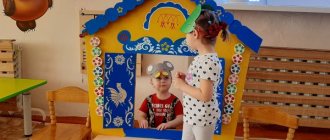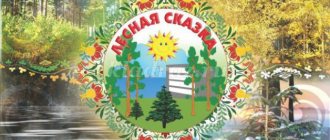Lesson on speech development in kindergarten. Senior group. Topic: Clothes
Summary of a lesson on the development of children's speech in the senior group on the topic: “Clothing”
Program objectives Educational: Continue to teach how to describe items of winter clothing Continue to teach to correctly answer the teacher’s questions with a complete answer Developmental: Clarify and systematize children’s ability to distribute clothes according to the seasons (Winter, summer) Educational: To develop a caring attitude towards clothing. Vocabulary work: Ancient man, winter, spring, summer, autumn, clothes, parcel, fur coat, hat, boots, scarf, mittens Materials and equipment: Envelope with the image of an ancient man, parcel, pictures depicting clothes at different times of the year, Preliminary work: Educator: writing notes, preparing material and equipment Children: Conversation on the topic of clothing, looking at illustrations depicting clothes, solving riddles “Clothing” Methodology Stages Contents Note Introductory part Educator : Guys today, when I went to kindergarten, I found K an envelope , do you want to know what's there? Let's quickly open it and see what's there. Educator : Look who is depicted in the picture? Children: An ancient man Educator : That's right, guys, this is an ancient man. He asks us to help him and tell him how to dress in the cold season. Children are sitting at tables
. I show the envelope, open it with the children, and pay attention to the image of an ancient man.
Main part. Educator: - B In ancient times, people lived in caves and made clothes from animal skins. - What do you think, if you and I were wearing such clothes now, what would happen to us? Children: Frozen / Educator: - Why would we freeze? Children: Because it’s cold outside now. Educator: That's right, guys. Late autumn has arrived. — If you met a person dressed in clothes made from animal skins, what would you advise him to wear in order not to freeze? Children: Jacket, boots, hat, mittens, scarf Educator: - Now guess what I suggest our primitive man wear. I’ll tell you riddles, and you guess Five fingers, like people’s, but her fingers have no nails. (glove) I walked along the road, I found two roads, I followed both. (Pants) House for the head. (Hat) It’s black, not earth, fluffy, not snow, warms, not a stove. Fur coat Educator: Well done guys, you guessed everything correctly, do you think a person will become warmer if he puts on these clothes? Children: yes. Educator: Now let's get up from the tables and rest a little. Winter has come. It's getting cold. (we spread our arms to the sides, cross them on our chests) Oh, yes. Oh, yes, yes. We are not afraid of the cold. (We clap the rhythm with our hands) So that our feet do not freeze, We put on boots (we alternately place our feet forward on the heel) Oh, yes. Oh, yes, yes. We are not afraid of the cold. (we stamp the rhythm with our feet) Hat, help us out, warm our ears. (rubbing our hands over our ears) Oh, yes. Oh, yes, yes. We are not afraid of the cold. (clap the rhythm with our hands) To warm our hands, we need to put on mittens. (imitates putting on mittens) Oh, yes. Oh, yes, yes. We are not afraid of the cold. (clap the rhythm with our hands) We’ll put on a new jacket and warm pants. (imitation of putting on a jacket and pants) Educator: Guys, what is the name of the clothes that we put on in winter? You need to answer in full Children: In winter we put on winter clothes Educator: That's right, but in the spring? Children: In the spring we put on spring clothes Educator: Well done, guys, and when summer comes, what clothes will we wear? Children: In the summer we wear summer clothes Educator : And in the fall? Children: In the fall we put on autumn clothes. Teacher : so we had a rest, and now let's play an interesting game. Did. Game “winter, summer” Purpose: To develop in children the skills of distributing clothes by season Educator: And now I suggest you divide clothes into winter and summer. Now everyone will come up to me and take a picture with a picture of clothes, you will need to attribute it to the right time of year.. Where winter clothes are shown we will put them in a parcel for an ancient person, and where summer clothes are shown we will put them aside Educator : Well done guys, they all coped well with the task Conversation on the topic “Clothing”. Educator: Please look at the board. What do you see on it? Children: Winter clothes Teacher: That's right, I will show you a picture of clothes and ask a question For example: “What kind of coat is this? (winter, warm). And you must answer with a complete answer. Everyone understood the task. Children: yes. Teacher: then let’s start completing it. What kind of jacket? (fur). What colour? What does the coat have? What does the jacket have? (collar, sleeves, pockets, buttons). What is a scarf for? (so that it is warm, so that it does not blow, so that the cold does not creep up your neck). About what we say “fluffy”, “fur”, “soft” I begin my story. I achieve logical thinking in children. I listen to the children's expected answers. each child who guessed goes to the table, finds the clothes they guessed, puts the shoes in a box (parcel) I praise the children I give a physical education lesson
Children imitate movements during the poem I ask children questions I encourage them to answer correctly with a complete answer I conduct a didactic game “Winter, Summer” Illustrations of winter clothes are on the board . I draw attention to the fact that children name color, individual qualities, and purpose. I ask several children. Final part. Teacher, well done guys, everyone turned out to have very good stories, he now knows how to dress correctly in the winter season. Guys, let's remember what we talked about today? Children: about clothes Teacher: what clothes do you know? Children: Jacket, fur coat, hat, boots, mittens, scarf Educator: Correct, what is the name of the clothes we wear in winter? Children: Winter clothes Educator: What about the clothes we wear in the summer? Children: Summer clothes Educator: Guys, for helping the Ancient Man, he sent you each a medal. I praise the children, We remove everything, I give medals to the children.
Download Summary of a lesson on speech development for children in the senior group on the topic: “Clothing”
We recommend watching:
Notes for a lesson on speech development in the senior group: Special purpose transport Notes for a lesson on speech development for children in the senior group of preschool educational institutions Notes for the development of speech in the senior group “Wild Animals of Russia” Notes for a lesson on speech development in the senior group. Nosov "Gardeners"
Similar articles:
Summary of a lesson on speech development in the senior group. Compiling a descriptive story based on a painting
Summary of a lesson on speech development in the senior group. Reading works of fiction
Summary of a lesson on speech development in the senior group. Retelling of a work of art. Charushin "Sparrow"
Summary of a lesson on ecology in the senior group of kindergarten on the topic “Man and Nature”
Lesson on emotional development in the senior group
Goal: to activate vocabulary on the topic “Clothing”, “Personal hygiene items”; continue to work on improving coherent speech; improve the grammatical structure of speech: consolidate the skill of correctly forming nouns in R. p. units. Part and plural; consolidate the skill of using antonym words in speech; consolidate the skill of using verbs within the framework of a lexical topic.
Cultivate a caring attitude towards clothing.
Integration of educational areas:
Speech development, cognitive development, social and communicative development, physical development.
Demonstration material: laptop, personal hygiene items (comb, soap, towel, toothbrush, shampoo, washcloth), game bag, visual material (pictures) for the game “What’s gone?”, mnemonic cards; 3 cups, 3 pieces of fabric (calico, leather, bolognese), syringe (for drawing water), a glass of water.
Progress of direct educational activities
I suggest children watch an excerpt from an already familiar cartoon.
— What is the name of the cartoon?
-Look at the boy - can we say that he is cheerful (sad), is he neat? is he hardworking? (lazy), is he neat? (sloppy).
-Why is he so grimy? (didn't wash)
-What did Moidodyr call the boy? (Oh, you disgusting, oh, you dirty, unwashed pig! You are blacker than a chimney sweep - admire yourself.)
- Are there any such dirty people among you?... Of course, because you all follow the rules of personal hygiene. Now we will check this with the help of the game “Wonderful Bag”. Having determined what you have in your hands, you must name the item and say what it is for.
Children take turns identifying personal hygiene items by touch: soap, towel, washcloth, comb, examine them by touch, smell and name the qualities of the item.
Let's start the game.
Soap: This is soap. You need it to soap your hands, face, and neck.
Towel: This is a towel. You need it to dry yourself.
Comb: This is a comb. It is needed to comb your hair.
Shampoo: This is shampoo. It is needed to wash your hair.
Toothbrush: This is a toothbrush. It is needed to brush your teeth.
— Guys, all these are called personal hygiene items.
-What happened to the boy?
- All things ran away from Petya. Let's remember what these things are with the help of the game "What's Missing?" (formation of the noun R.p. singular and plural)
-There are picture cards on the table. You only need to choose clothes and say what Petya doesn’t have. (Pants - no trousers, T-shirt - no T-shirt, etc.)
-Do you know how to care for clothes?
-If she gets dirty, then her (clothes are washed, shoes are washed, cleaned).
-If wrinkled - (clothes are ironed)
-If it’s torn—(sutured up)
-If a button comes off, then it is (sewn on)
Physical education minute
Kolya, Kolya, Nikolai, clean up after yourself! (walk in a circle one after another)
Your hands are lazy (clap your hands)
Belt and trousers under the table, (squats)
The shirt is not in the closet, (“draw” a quadrangle)
Nikolai is a slob. (they shake their finger and shake their head)
All of Petya's clothes ran away. Tell us what clothes escaped. And hint cards will help you with this (making sentences using mnemonic tracks).
- Guys, do we always wear the same clothes in winter, summer...?
- Guys, what time of year is it now?
-Name the signs of autumn. (I let the children know that autumn is rainy).
-What clothes should you wear in rainy weather so as not to get wet? (jacket).
-Not any jacket can protect us from the rain. Now we will check what material a jacket can help us with. Here are three types of fabric: calico, bolognese, leather. Let's pour a little water on each piece of fabric and see which fabric will not allow water to pass through.
An experiment is being carried out.
At the end of the experiment I ask the question:
-What conclusion can be drawn? (A jacket made of Bolognese and leather fabric can “save us” from the rain).



